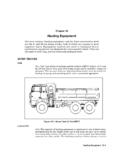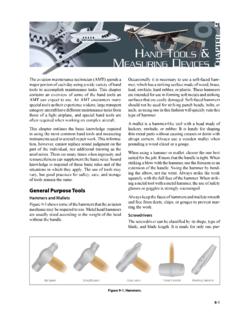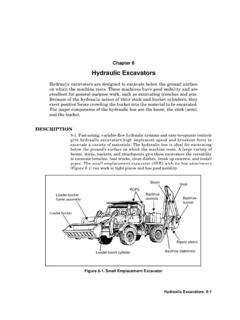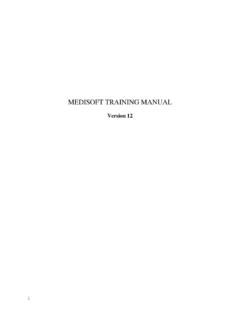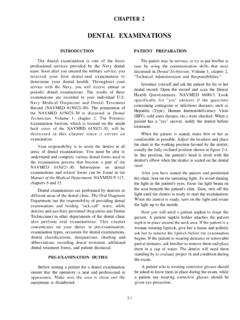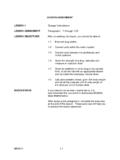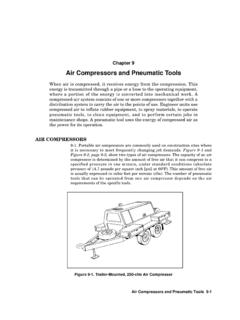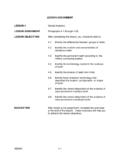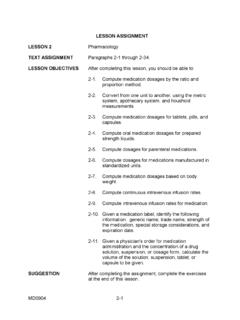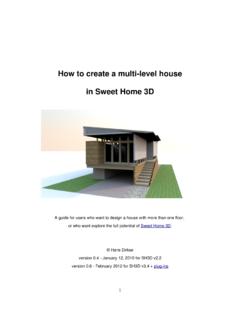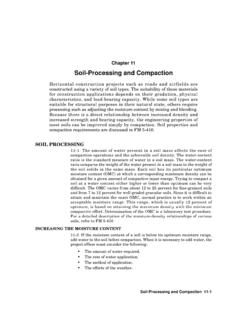Transcription of Loaders - sweethaven02.com
1 Loaders 5-1 Chapter 5 LoadersLoaders are used extensively in construction operations to handle andtransport material, to load haul units, to excavate, and to chargeaggregate bins at both asphalt and concrete plants. The loader is aversatile piece of equipment designed to excavate at or above wheel ortrack level. The hydraulic-activated lifting system exerts maximumbreakout force with an upward motion of the bucket. Large rubber tires onwheel models provide good traction and low ground-bearing pressure. Awheel loader can attain high speeds, which permits it to travel from onejob site to another under its own Military Loaders are diesel-driven, rubber-tired machines (Figure 5-1,page 5-2). They are available in varied sizes and capacities. A power-shifttransmission with a torque converter gives the Loaders fast-movementcapability in both forward and reverse, with a minimum of shock.
2 This lets themachines maintain a high production rate. The hydraulic system gives theoperator positive control of mounted attachments and assists with Loaders have pintles or towing hooks for towing small trailers or The most common loader attachments are a shovel-type bucket or aforklift (Figure 5-2, page 5-3). The loader s hydraulic system provides thepower necessary for operating these attachments. Hooks (designed for liftingand moving sling loads) and snowplows are other available Buckets may be general-purpose (one-piece, conventional) or multipurpose(two-piece, hinged-jaw) (Figure 5-2). The bucket attaches to the tractor unit bylift arms. Buckets are made of heavy-duty, all-welded steel and vary in sizefrom to 5 cubic yards. The bucket teeth are bolted or welded ontoreplaceable cutting edges. Bolt-on, replaceable teeth are provided forexcavation of medium-type materials.
3 The multipurpose bucket provides thecapability to use the loader as a dozer and to grab A forklift can be attached to the tractor unit in place of a bucket. Designedfor material handling, the fork attachment is made of steel with two 5-4345-2 Loaders Figure 5-1. Wheel LoaderMultipurpose bucketCab(ROPS)FM 5-434 Loaders 5-3 Figure 5-2. Loader AttachmentsUSE5-5. Typical uses for a loader are loading trucks; stockpiling materials; diggingbasements or gun emplacements; backfilling ditches; lifting and movingconstruction materials; and, when equipped with rock-type-tread tires,operating in and around rock quarries. They may also be used for manymiscellaneous construction tasks. These include stripping overburden,charging hoppers and skips, lifting and moving forms for concrete work,moving large concrete and steel pipes, assisting with plant erection andmaintenance, and towing small trailers and light Two critical factors to consider in selecting a loader are the type andvolume of material being handled.
4 Loaders are excellent machines forexcavating soft to medium-hard material. Loader production rates decreaserapidly when excavating medium to hard material. Another factor to consideris how high the material must be raised. To be of value in loading trucks, theloader must be able to dump over the side of the truck s dump bed. A loaderattains its highest production rate when working on a flat, smooth surfacewith enough space to maneuver. In poor underfoot conditions or when there isa lack of space to operate efficiently, other equipment may be more THE BUCKET5-7. When loading the bucket, it should be parallel with the ground so itscutting edge can skim the travel surface and remove ruts, obstacles, and loosematerial on the forward pass. As the cutting edge contacts the bank orstockpile, move the loader forward at a slow speed and increase the bucketForkliftFM 5-4345-4 Loaders While penetrating the material, raise the bucket.
5 Crowd the material into thebucket and roll the bucket back to prevent spilling. Maintain the bucket in anupward position while backing away, to prevent OF HAUL UNITS5-8. Proper positioning of the equipment that will receive material from theloader is necessary for maximum production. This cuts down on METHOD5-9. When loading trucks from a bank or a stockpile with a single loader, usethe V-loading method. Use the following steps for the V-loading method(Figure 5-3).Step 1. With the bucket lowered 1 to 2 inches off the ground, head the loadertoward the bank or stockpile in low 2. Move the loader into the stockpile and manipulate the lift and tilt con-trol levers, simultaneously curling back the bucket and raising the boomslightly until the bucket is full and completely rolled back. Maintain powerwithout spinning the 3.
6 Hold the bucket in the upright and curled position, and back away fromthe stockpile or 4. Approach the haul unit at a 90 angle, lifting the bucket high enough toclear the haul 5. Proceed slowly forward until the bucket is over the haul unit. Do nottouch the haul unit with the front 6. Dump the bucket by rolling the bucket slowly forward. Do not let thebucket hit the haul 7. Back away from the haul unit while simultaneously lowering the boomand leveling the the above steps until the haul unit is : While these machines are flexible and can dig under very awk-ward conditions, the best production is achieved by keeping both theangle of turn and the travel distance to a LOADING5-10. This procedure can be used with the multipurpose bucket for handlingrocks, timbers, or stockpiles of loose 1. Center the front of the bucket on the middle of the first load to be pickedup.
7 When about 5 feet from the load, begin to open the 2. Move the loader forward and make contact with the load. About two-thirds of the opened bucket should penetrate into the material to be 3. Close the bucket to secure the 5-434 Loaders 5-5 Step 4. Position the load 10 to 14 inches above the 5. Maneuver the loader to the desired location for load 6. Open the bucket 7. Raise the bucket high enough to clear any previously dumped that all of the material is out of the 5-3. Loading Trucks With a Loader (V-Loading Method)CAUTIONKeep the loader bucket as low as possible. A low bucketposition provides better balance and operator traveling with a full bucket over rough terrain orterrain that can cause the loader to slide, always operateat low speed. Failure to do so can result in loss of control,causing serious injury or loss of life and a frontal approach to the tank or the bucket and back away from the the haul unit (truck) at a 90o angle to load the 5-4345-6 Loaders Step 8.
8 Close the 9. place the bucket in the traveling position (10 to 14 inches above theground).Repeat the above steps until the task is BASEMENTS AND GUN EMPLACEMENTS5-11. A loader can dig excavations such as basements or gun emplacements ifthe material is not too hard. The operator should first construct a ramp intothe excavation (Figure 5-4). Because the loader works best when excavatingabove wheel level, the ramp allows the loader to work in that manner andlater provides egress to bring out the material. The following procedures areused to construct a 1. Determine a starting point for the 2. Position the bucket so it is pitched 3. Move the loader forward, gradually penetrating the earth by loweringthe lift control lever. Keep the loader in as high a gear as possible without causing the tiresto spin excessively.
9 Regulate the depth of cut using the lift control 4. Retract the bucket 5. place the lift control lever in the raised position until the bucket is highenough to clear the surrounding 6. Dump the loaded bucket onto a stockpile or into a haul the above steps until the excavation is IN DIFFICULT MATERIAL5-12. The multipurpose bucket handles sticky material (which has a tendencyto cling to the bucket) better than the general-purpose bucket. A clam-typedigging motion works best in this material type. When digging medium tohard material, a greater efficiency can be achieved by first breaking orloosening the 5-4. Constructing a Ramp into an ExcavationFM 5-434 Loaders 5-7 BACKFILLING5-13. When backfilling trenches, lower the bucket to grade level and use theforward movement of the machine to push the stockpiled earth into the trench(Figure 5-5).
10 This type of work is ideal for the loader as long as the bucket is aswide as, or wider than, the loader s wheels or tracks. Narrow buckets causethe wheels to ride up the stockpile. This raises one corner of the bucket andrequires more passes. Use the following steps to perform 1. Align the loader with the stockpile (either to the left or right side) whileapproaching at a 45 angle so that one-third of the bucket will contact the : This technique will not work when pushing a large stockpile. Inthis case, work from the 2. Adjust the bucket by moving the lift control lever to lower the bucket tojust off of the natural ground. If using a multipurpose bucket, move the bucketcontrol lever to open the bucket to the clam 3. Move the loader forward and gradually move the material. Keep theloader in as high a gear as possible without causing the tires to spin 4.
